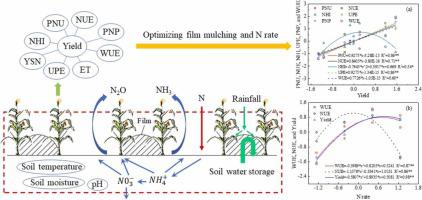Agricultural Water Management ( IF 6.7 ) Pub Date : 2021-11-25 , DOI: 10.1016/j.agwat.2021.107350 Heng Fang 1, 2 , Yuannong Li 1 , Xiaobo Gu 1 , Meng Yu 1 , Pengpeng Chen 1 , Yupeng Li 1 , Fulai Liu 2

|
Film mulching and nitrogen fertilization are two effective practices to promote maize production in northwest China, but their impacts on environment in terms of greenhouse gas emission remain unclear. Two-year field trials were conducted to 1) explore the effect of the film mulching pattern and N fertilization rate on maize production, gaseous N emission, and utilization of N and water; 2) find an optimal mulching pattern and N-fertilization rate to achieve green development. Trial Ⅰ included flat planting with non-mulching (NM), ridge-furrow with plastic film mulch (PM), ridge-furrow with biodegradable film mulch (BM), and flat planting with full plastic film mulching (FM). Trial Ⅱ involved BM with N-fertilization rates (0, 90, 180, and 270 kg N ha−1), denoted as BMN0, BMN1, BMN2, and BMN3, respectively. The results showed that film mulching significantly decreased the daily flux and cumulative flux of gaseous N by an average of 32.02%, 35.17% (NH3), 78.70%, 75.83% (N2O), respectively, as compared with NM. Film mulching also significantly increased the amount of soil residual mineral N after harvest, plant N uptake, and soil water storage but decreased evapotranspiration by an average of 8.31%, 9.42%, 17.45%, and 25.34%, respectively, as compared with NM. In addition, grain yield, water use efficiency (WUE), N uptake efficiency (UPE) (except for BM), N harvest index (NHI), N use efficiency (NUE), and partial productivity of N (PNP) were significantly higher in the mulching treatments, and yield–scaled NH3 emission (YSN) was significantly lower in PM and BM, as compared with NM. Compared with FM, soil residual mineral N after harvest, plant N uptake, grain yield, WUE, NUE, and PNP were significantly lower but NHI was significantly higher in PM and BM. The daily flux and cumulative flux of N2O emission and the amount of soil residual NO3− -N after harvest were significantly lower but plant N uptake was significantly higher in PM than in BM. Collectively, BM was the best mulching treatment in this study. With increase of N-fertilization rate, the daily flux and cumulative flux of NH3 volatilization, the peak period, and the cumulative flux of N2O emission, the grain yield, WUE, NUE (except for N3), and YSN were significantly increased but NHI, PNP, and UPE were significantly decreased. The optimum N-fertilization rate under BM was found at 173 kg ha−1, which could achieve the goal of high yield, efficient utilization of water and nitrogen, and environmental friendliness.
中文翻译:

优化地膜模式和施氮量对西北地区玉米产量、气态氮排放和水氮利用的影响
地膜覆盖和施氮肥是促进西北地区玉米生产的两种有效措施,但其温室气体排放对环境的影响尚不清楚。进行了为期两年的田间试验,以 1) 探索地膜覆盖模式和施氮量对玉米产量、气态氮排放以及氮和水利用的影响;2)寻找最佳覆盖方式和施氮量,实现绿色发展。试验Ⅰ包括平植不覆膜(NM)、垄沟覆膜(PM)、垄沟覆膜(BM)、平植全覆膜(FM)。试验 Ⅱ 涉及 BM 施氮率(0、90、180 和 270 kg N ha -1),分别表示为 BMN0、BMN1、BMN2 和 BMN3。结果表明,与NM相比,地膜覆盖显着降低了气态N的日通量和累积通量,平均分别降低了32.02%、35.17% (NH 3 )、78.70%、75.83% (N 2 O)。与 NM 相比,地膜覆盖还显着增加了收获后土壤残留矿质 N 量、植物 N 吸收和土壤蓄水量,但使蒸散量平均分别降低了 8.31%、9.42%、17.45% 和 25.34%。此外,粮食产量、水分利用效率(WUE)、N吸收效率(UPE)(BM除外)、N收获指数(NHI)、N利用效率(NUE)和N部分生产力(PNP)均显着较高在覆盖处理中,和产量规模的 NH 3与 NM 相比,PM 和 BM 的排放(YSN)显着降低。与FM相比,收获后土壤残留矿质氮、植物吸氮量、粮食产量、WUE、NUE和PNP显着降低,但PM和BM中NHI显着升高。收获后N 2 O 排放的日通量和累积通量以及土壤残留NO 3 - -N 量显着降低,但PM 中植物对N 的吸收显着高于BM。总的来说,BM 是本研究中最好的覆盖处理。随着施氮量的增加,NH 3挥发的日通量和累积通量、高峰期和N 2的累积通量O排放、粮食产量、WUE、NUE(N3除外)和YSN显着增加,而NHI、PNP和UPE显着降低。BM下最佳施氮量为173 kg ha -1,可实现高产、水氮高效利用和环境友好的目标。



























 京公网安备 11010802027423号
京公网安备 11010802027423号